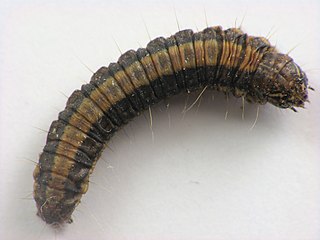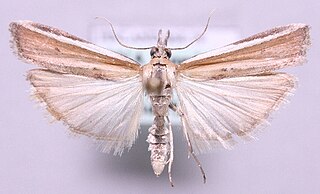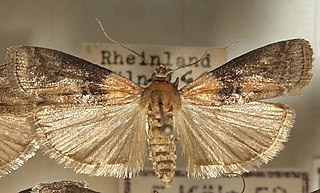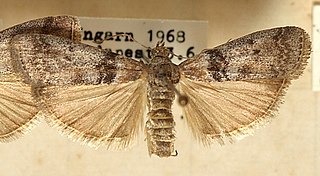
Crambinae is a large subfamily of the lepidopteran family Crambidae, the crambid snout moths. It currently includes over 1,800 species worldwide. The larvae are root feeders or stem borers, mostly on grasses. A few species are pests of sod grasses, maize, sugar cane, rice, and other Poaceae. The monophyly of this group is supported by the structure of the tympanal organs and the phallus attached medially to the juxta.

Acrobasis is a genus of moths of the family Pyralidae.

Agriphila is a genus of small moths of the family Crambidae. It was first described by Jacob Hübner in 1825. They are common across temperate Eurasia and in adjacent regions.

Anania is a genus of moths of the family Crambidae described by Jacob Hübner in 1823.

Pyrausta is a specious genus of moths of the family Crambidae. The genus was erected by Franz von Paula Schrank in 1802.

The Epipaschiinae are a subfamily of snout moths. Almost 600 species are known today, which are found mainly in the tropics and subtropics. Some occur in temperate regions, but the subfamily is apparently completely absent from Europe, at least as native species. A few Epipaschiinae are crop pests that may occasionally become economically significant.
Homoeosoma is a genus of moths of the family Pyralidae.
Ancylosis is a genus of snout moth. It was described by Philipp Christoph Zeller in 1839, and is known from South Africa, Uzbekistan, Spain, Turkmenistan, Lebanon, Algeria, Tunisia, Russia, Israel, Palestine, Tinos, Australia, Seychelles, Afghanistan, the United States, Iraq, Namibia, Kazakhstan, Iran, Mauritius, Mozambique, Sarepta, Argentina, Sri Lanka, and Aden.

Pococera is a genus of snout moths in the subfamily Epipaschiinae, found mainly in North and Central America. It was described by Philipp Christoph Zeller in 1848.
Asclerobia is a genus of snout moths. It was erected by Rolf-Ulrich Roesler in 1969 and is known from China and Japan.
Dioryctria is a genus of snout moths. It was described by Philipp Christoph Zeller in 1846.

Euzophera is a genus of snout moths. It was described by Philipp Christoph Zeller in 1867.
Bandera is a genus of snout moths. It was described by Émile Louis Ragonot in 1887 and is known from the United States.
Zophodia is a genus of snout moths in the subfamily Phycitinae. It was erected by Jacob Hübner in 1825.

Pima is a genus of snout moths described by George Duryea Hulst in 1888.
Pempelia is a genus of moths of the family Pyralidae described by Jacob Hübner in 1825.
Moodna is a genus of snout moths described by George Duryea Hulst in 1890.
Salebriaria is a genus of snout moths. It was described by Carl Heinrich in 1956.

Peoria is a genus of moths of the snout moth family (Pyralidae). The genus was erected by Émile Louis Ragonot in 1887.

















